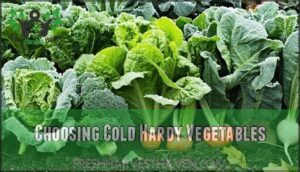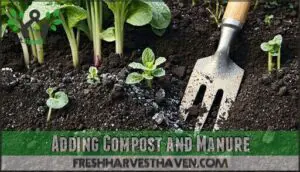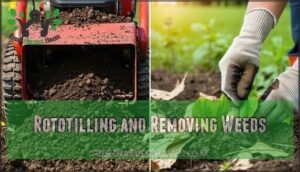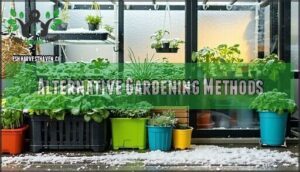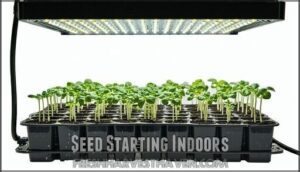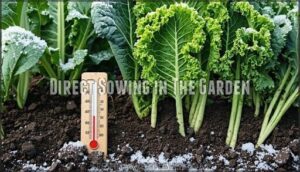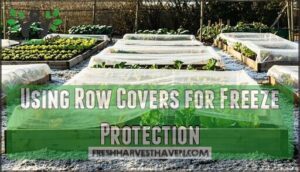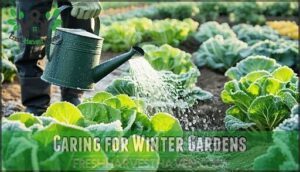This site is supported by our readers. We may earn a commission, at no cost to you, if you purchase through links.
 Vegetable gardening in cold climates isn’t just possible—it’s rewarding when you know the tricks.
Vegetable gardening in cold climates isn’t just possible—it’s rewarding when you know the tricks.
You’ll want to choose hardy varieties like kale, Brussels sprouts, and root vegetables that actually taste sweeter after frost.
Start seeds indoors 6-8 weeks before your last frost date, then transplant after hardening off.
Prepare your soil in fall with compost and organic matter since frozen ground won’t cooperate later.
Row covers, cold frames, and mulch become your best friends for extending seasons.
Cold-hardy crops can survive temperatures down to 20°F with proper protection.
Winter gardening transforms challenges into opportunities for fresh produce year-round.
Table Of Contents
- Key Takeaways
- Choosing Cold Hardy Vegetables
- Preparing Soil for Winter
- Planting Strategies for Cold Climates
- Caring for Winter Gardens
- Extending Growing Season
- Frequently Asked Questions (FAQs)
- What temperature is too cold for a vegetable garden?
- What vegetables thrive in cold weather?
- What is the lowest temperature vegetable plants can tolerate?
- How to grow vegetables in cold climates?
- What vegetables grow best in a cold climate?
- What temperature is too cold for vegetable garden?
- Can vegetable plants survive 40 degree weather?
- How do I protect my vegetable garden from cold weather?
- What vegetables grow best in cold weather?
- Can vegetables grow in 50 degree weather?
- Conclusion
Key Takeaways
- Choose frost-tolerant varieties like kale, Brussels sprouts, and root vegetables that actually taste sweeter after frost hits – they’ll survive temperatures down to 20°F with proper protection.
- Prepare your soil in fall by adding 2-3 inches of compost or aged manure and working it into the top 6-8 inches, since you can’t work frozen ground later.
- Use protective covers strategically – row covers, cold frames, and thick mulch create microclimates that extend your growing season by 4-6 weeks and shield plants from harsh conditions.
- Start seeds indoors 6-8 weeks before your last frost date, then harden them off gradually over 7-10 days before transplanting to give plants a crucial head start against cold weather.
Choosing Cold Hardy Vegetables
Success in cold climate gardening starts with selecting the right hardy vegetable varieties.
Frost-resistant vegetables like kale, spinach, and Brussels sprouts actually improve in flavor after freezing, making them perfect winter crops.
Root establishment becomes essential when you plant these coldhardy vegetables in late summer. Check your Hardiness Zone and look for seed packets labeled "short season" or "frost hardy."
Vegetable varieties such as carrots, turnips, and leeks store energy underground, staying protected and flavorful through harsh conditions.
Understanding a plant’s vegetable hardiness is key to successful cold climate gardening. Plant these frost resistant vegetables by early September for best results.
Preparing Soil for Winter
Cold climates demand extra attention to soil preparation since frozen ground and harsh conditions can stress your vegetables throughout winter.
You’ll need to enrich your soil with organic matter and create the right growing environment before the cold weather arrives.
Adding Compost and Manure
Once you’ve selected your cold-hardy vegetables, it’s time to give your soil the nutrients it needs to support winter growth. Adding organic matter through compost and manure creates the foundation for healthy plants that can withstand harsh conditions.
Compost benefits include improved soil structure and enhanced nutrient availability. Well-aged compost provides slow-release nutrients while building soil health over time. Manure types like cow, horse, or chicken manure offer different nutrient profiles – chicken manure provides more nitrogen, while cow manure offers balanced nutrition.
Follow these application methods for best results:
- Spread 2-3 inches of well-aged compost or manure across garden beds
- Keep organic matter away from plant stems to prevent rot
- Work amendments into the top 6-8 inches using a garden fork
- Apply compost tea for immediate nutrient balance in depleted soils
This soil enrichment process improves drainage and creates soil warming techniques that help roots establish before winter arrives. You can find various compost options available to suit your specific gardening needs.
Rototilling and Removing Weeds
Beyond surface-level soil preparation, rototilling depth matters more than you’d think.
Work soil when it’s slightly moist—not muddy—to avoid creating concrete-like soil compaction.
Till to 6-8 inches deep, mixing compost effectively while improving aeration for root development.
Weed management requires strategy before winter sets in.
Hand-pull weeds in smaller gardens, or smother large patches with cardboard.
Don’t let weeds steal nutrients during dormant months.
Remember, disturbing soil awakens dormant weed seeds, so time your rototilling wisely.
Consider weed prevention through organic herbicides like corn gluten meal applied before seeds germinate.
Tool maintenance keeps equipment sharp and efficient.
For healthy soil, balance disturbance with preservation—sometimes minimal tilling works better than aggressive cultivation.
Your soil preparation foundation determines next season’s success, so prepare thoughtfully for ideal weed removal results.
Alternative Gardening Methods
When traditional soil gardening hits winter roadblocks, alternative methods offer creative solutions.
These techniques bypass poor soil conditions and extend your growing season effectively.
Consider these five innovative approaches:
- Raised bed gardening warms soil 2-4°F faster than ground-level beds, improving drainage during freeze-thaw cycles.
- Container gardening lets you relocate plants to warmer spots; black pots retain 5°F more heat on sunny days.
- Straw bales generate internal heat through decomposition while providing excellent insulation for root zones.
- Hydroponics delivers nutrients through water, eliminating soil temperature concerns entirely for year-round production.
- Cold frame gardening creates mini-greenhouse conditions, protecting plants from harsh frost while maintaining accessibility.
These season extension methods transform challenging climates into productive growing opportunities.
Planting Strategies for Cold Climates
Successfully growing vegetables in cold climates starts with smart planting strategies that work with nature’s rhythm rather than against it.
You’ll need to master three key techniques: starting seeds indoors for a head start, direct sowing at the right outdoor temperatures, and using protective covers to shield your plants from unexpected frosts.
Seed Starting Indoors
Once your soil’s ready, indoor seed starting gives your plants a head start against harsh weather. Start seeds 6-8 weeks before your last frost date using lightweight Potting Mixes that drain well—never use garden soil indoors.
For many, starting seeds indoors provides a head start on the growing season.
Indoor Lighting makes all the difference. Grow lights provide 16 hours of daily light for strong seedlings. Windows won’t cut it during winter months.
Maintain Seedling Heat with heat mats to boost seed germination rates. Most seeds need 68-86°F soil temperatures to sprout quickly.
Monitor Watering Needs carefully—keep soil moist but not soggy to prevent damping off disease.
Hardening Off prepares seedlings for outdoor conditions. Gradually expose them to outside temperatures over 7-10 days before transplanting.
Indoor Lighting
Potting Mixes
seed germination
Direct Sowing in The Garden
Direct sowing works well in cold climates when you choose the right approach. Plant frost-tolerant vegetables like carrots and kale once soil temperature reaches 40°F. Use proper seed depth—twice the diameter of each seed—to help retain warmth. Create windbreaks using taller plants or barriers to protect emerging seedlings from harsh winds.
Frost-tolerant crops like radishes thrive between 26-32°F.
- **Why try direct sowing?
- It’s fast and efficient.
- Seeds adapt to natural conditions.
- No transplant shock!
- Pro tip: Check your soil temperature with a thermometer before planting, and remember that proper watering needs and weed control will help your directly sown vegetables thrive through thinning seedlings stage.
Using Row Covers for Freeze Protection
Row covers act like protective shields for your vegetable gardening efforts in cold climates.
These lightweight fabrics protect plants from frost while allowing sunlight, water, and air to pass through naturally.
| Row Cover Types | Temperature Protection | Best Uses |
|---|---|---|
| Lightweight fabric | 2-4°F protection | Light frost protection |
| Medium weight | 4-6°F protection | Moderate cold spells |
| Heavyweight | 6-10°F protection | Severe frost events |
Installation techniques are straightforward: drape the fabric over hoops or supports, then secure edges with soil, rocks, or clips to prevent wind damage.
You’ll want to check ventilation needs regularly—remove covers during warm days to prevent overheating and allow pollination.
Row covers excel at pest control too, creating barriers against insects while extending growing season length.
They’re cost-effective frost protection methods that keep your harvest thriving through unpredictable weather.
Consider the various options for gardening row covers to best suit your specific needs.
Winter watering becomes easier since covers help retain soil moisture while protecting plants from harsh elements.
Caring for Winter Gardens
Once your winter vegetables are planted, they’ll need consistent care to survive harsh conditions and produce quality harvests.
Your focus should shift to protecting plants from extreme weather while maintaining their health through targeted watering, feeding, and pest management strategies.
Watering and Mulching
Once your plants are established, mastering winter watering becomes your next challenge.
Watering frequency changes dramatically when temperatures drop—frozen soil won’t absorb water, so timing matters.
Water deeply during warmer spells when soil moisture can actually penetrate the ground.
This approach helps roots stay hydrated through cold snaps.
Mulch types play a huge role in soil insulation and maintaining moisture levels.
Think of mulch as your garden’s winter jacket—it keeps everything cozy underneath.
- Straw mulch: Excellent insulation methods that trap air pockets for warmth
- Shredded leaves: Free organic matter that breaks down slowly over winter
- Wood chips: Long-lasting option that prevents soil temperature fluctuations
Apply 2-3 inches around plants, keeping material away from stems to prevent rot.
This simple step maintains moisture while providing essential soil insulation throughout winter’s harsh conditions.
Fertilizing and Pruning
The art of fertilizing and pruning winter vegetables requires finesse, not force.
Skip heavy feeding in late fall—your plants need rest, not a nutrient overload.
Instead, focus on soil amendments like aged compost or lime to address nutrient deficiencies revealed through soil testing.
When soil begins warming, apply balanced fertilizer sparingly to encourage strong root development.
Organic fertilizer works wonderfully for gradual nutrient release.
Winter pruning becomes your secret weapon for plant health.
Use clean pruning techniques to remove damaged or dead stems—think surgical precision, not chainsaw massacre.
These careful cuts help plants conserve precious energy for spring growth.
To further protect plants, consider covering sensitive plants during cold snaps.
Different fertilizer types serve various purposes, but moderation wins every time.
Your vegetables will thank you with robust spring shoots when you’ve balanced their winter nutrition and maintained their structure through thoughtful pruning practices.
Managing Pests and Diseases
Winter gardens face unique pest and disease challenges that require strategic management. Pest identification becomes vital when cabbage worms and aphids persist despite cold temperatures, while disease prevention focuses on clubroot and downy mildew threats in damp conditions.
Essential winter pest management strategies:
- Deploy physical barriers – Floating row covers exclude 80% of moths and beetles while protecting against frost damage simultaneously.
- Maintain strict garden hygiene – Remove crop debris and rotate plant families to disrupt overwintering pest cycles and reduce soilborne pathogens by 30-50%.
- Apply targeted organic controls – Use beneficial insects like ladybugs for aphid suppression, and neem oil for broader pest management without harming pollinators.
Disease-resistant plants combined with proper spacing improves airflow, preventing fungal issues before they establish.
Extending Growing Season
When winter approaches, you don’t have to give up on fresh vegetables from your garden.
Smart season extension techniques let you harvest homegrown produce well into the cold months and get an early start on spring planting.
Using Greenhouses and Cold Frames
When winter temperatures threaten your garden, greenhouses and cold frames become your reliable partners in greenhouse gardening cold weather. These season extenders create protected microclimates that shield plants from harsh conditions while extending your growing season.
Cold Frame Design starts with selecting durable materials. Build sturdy frames using rot-resistant wood or aluminum, then top with polycarbonate panels for superior insulation and light transmission. These panels outperform glass by retaining heat better while resisting impact damage.
Greenhouse Ventilation requires daily attention to prevent overheating. Install automatic vent openers that respond to temperature changes, maintaining ideal airflow without constant monitoring. They can extend the growing season by 4-6 weeks.
- Light Management involves positioning structures to capture maximum southern exposure while avoiding wind tunnels
- Heating Options include thermal mass like water barrels or compost piles that store and release heat naturally
Proper ventilation and Pest Control through regular cleaning keep your protected plants thriving through winter’s challenges.
Applying Row Covers and Mulch
Two key tools transform your cold-climate garden into a year-round sanctuary. Row cover types include lightweight fabric for gentle frost protection and heavy-duty materials for severe winters.
Choose mulch material options like straw, shredded leaves, or wood chips for soil insulation. Application timing matters—install row covers before temperatures drop and apply mulch after the first light freeze to prevent pest harboring.
This combo delivers pest protection while maintaining temperature regulation around plants. Row covers trap warm air while allowing light penetration, and mulch acts like a blanket for roots.
Together, they boost frost tolerance and succeed at extending growing season by creating protective microclimates that shield vegetables from harsh winter conditions.
Choosing Varieties With Longer Maturity Dates
Timing your variety selection makes all the difference when extending your cold-climate harvest.
Late-Season Crops like ‘Winterbor’ kale (75 days) and ‘Blue Solaise’ leeks (120 days) reward patient gardeners with Extended Harvest potential through winter months.
Strategic Variety Selection based on Maturity Length transforms your garden’s productivity:
- Brussels sprouts varieties mature in 90-120 days, surviving temperatures down to 20°F
- Winter leeks need 120 days but withstand hard frosts and snow cover
- Long-season carrots develop natural sugars after 85 days, improving sweetness post-frost
- Hardy kale cultivars provide continuous harvests with proper Planting Time coordination.
Match maturity dates with your region’s frost dates for ideal results.
Frequently Asked Questions (FAQs)
What temperature is too cold for a vegetable garden?
Most vegetables can’t handle temperatures below 32°F, but hardy crops like kale, Brussels sprouts, and carrots actually thrive in temps down to 20°F with proper protection.
What vegetables thrive in cold weather?
Cold-loving crops aren’t just survivors—they’re thrivers!
Root vegetables like carrots, beets, and turnips actually sweeten after frost.
Leafy greens including kale, spinach, and Brussels sprouts handle freezing temperatures beautifully, delivering fresh harvests.
What is the lowest temperature vegetable plants can tolerate?
Most vegetables can handle temperatures down to 28-32°F, but hardy greens like kale and Brussels sprouts survive much colder conditions.
Even withstanding temperatures as low as 10-20°F when properly established.
How to grow vegetables in cold climates?
Start with cold-hardy varieties like kale, spinach, and Brussels sprouts. Prepare soil with compost, use row covers for frost protection, and plant in raised beds for better drainage and warming.
What vegetables grow best in a cold climate?
Picture Sarah’s Minnesota garden: while her neighbors’ tomatoes freeze, her kale, carrots, and Brussels sprouts thrive through frost.
Root vegetables like beets, turnips, and radishes excel because they store energy underground, staying sweet even after freezing temperatures hit your garden beds.
What temperature is too cold for vegetable garden?
Most vegetables can’t handle temperatures below 32°F, though hardy varieties like kale and Brussels sprouts tolerate down to 20°F. You’ll need protection when temps drop below 28°F consistently.
Can vegetable plants survive 40 degree weather?
Like winter warriors braving nature’s chill, most vegetable plants can survive 40°F weather quite well.
You’ll find many cold-hardy varieties actually thrive at this temperature, making it ideal for planting frost-tolerant crops.
How do I protect my vegetable garden from cold weather?
You’ll want to use row covers, blankets, or garden cloths to trap warm air around your plants.
Add thick mulch around plant bases to insulate roots and regulate soil temperature effectively.
What vegetables grow best in cold weather?
Root vegetables, leafy greens, and brassicas thrive in chilly conditions. You’ll find carrots, kale, spinach, and Brussels sprouts actually taste sweeter after frost hits them.
Can vegetables grow in 50 degree weather?
Yes, many vegetables thrive in 50-degree weather.
Cool-season crops like lettuce, spinach, kale, carrots, and radishes actually prefer these temperatures.
They’ll grow steadily and often taste sweeter than in hot weather, which makes 50-degree weather ideal for them.
Conclusion
Summer’s warmth fades while winter’s harsh grip tightens, yet your garden doesn’t have to surrender.
Successful vegetable gardening in cold climates demands planning, patience, and proven techniques.
You’ve learned to select frost-tolerant varieties, prepare soil properly, and protect plants through challenging months.
Cold frames extend seasons while proper mulching shields roots from freezing temperatures.
Start planning your cold-weather garden now, and you’ll enjoy fresh vegetables when neighbors think growing season has ended completely.
- https://homesteadingfamily.com/gardening-in-winter-cold-weather-growing-methods/
- https://gardeningsolutions.ifas.ufl.edu/plants/edibles/vegetables/endive.html/
- https://specialtyproduce.com/produce/Mizuna_Lettuce_2027.php
- https://www.marthastewart.com/286437/radicchio-recipes
- https://www.seedsnow.com/blogs/news/fall-and-winter-crops

